
Trento, also anglicized as Trent, is a city on the Adige River in Trentino-Alto Adige/Südtirol in Italy. It is the capital of the autonomous province of Trento. In the 16th century, the city was the location of the Council of Trent. Formerly part of Austria and Austria-Hungary, it was annexed by Italy in 1919. With 120,709 inhabitants, Trento is the third largest city in the Alps and second largest in the Tyrol.
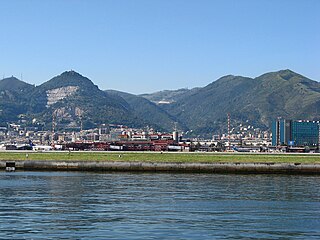
Genoa Airport also named Christopher Columbus Airport, and commonly named Aeroporto di Genova-Sestri Ponente, after the city district where it is located) is an international airport built on an artificial peninsula, 4 NM west of Genoa, Italy.

Alessandro Vittoria (1525–1608) was an Italian Mannerist sculptor of the Venetian school, "one of the main representatives of the Venetian classical style" and rivalling Giambologna as the foremost sculptors of the late 16th century in Italy, producing works such as Annunciation.

Mauro Darío Jesús Cetto is a retired Argentine footballer who played as a defender. He lastly worked as the sporting director of Rosario Central.
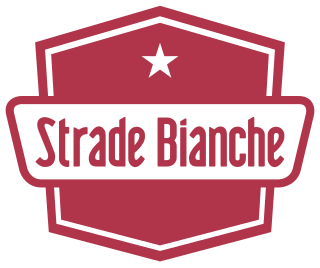
The Strade Bianche is a road bicycle race in Tuscany, Central Italy, starting and finishing in Siena. First held in 2007, it is raced annually on the first or second Saturday of March. The name Strade Bianche stems from the historic white gravel roads in the Crete Senesi, which are a defining feature of the race. One third of the total race distance is raced on dirt roads, covering 63 km of strade bianche, spread over 11 sectors.

Via Giuseppe Garibaldi is a street in the historical centre of Genoa, in Northwestern Italy, well known for its ancient palaces. It is one of the Strade Nuove built by the Genoese aristocracy during the Renaissance. Since July 2006 it is inscribed in the list of UNESCO World Heritage Site Genoa: the Strade Nuove and the system of the Palazzi dei Rolli.

The Palazzo Brignole Sale or Palazzo Rosso is a house museum located in Via Garibaldi, in the historical center of Genoa, in Northwestern Italy. The palace is part of the UNESCO World Heritage Site Genoa: Le Strade Nuove and the system of the Palazzi dei Rolli. The rich art collection inside, along with the galleries of Palazzo Bianco and Palazzo Doria Tursi, is part of the Musei di Strada Nuova and consists of the works of artists of the caliber of Antoon van Dyck, Guido Reni, Paolo Veronese, Guercino, Gregorio De Ferrari, Albrecht Dürer, Bernardo Strozzi and Mattia Preti.

Genoa: Le Strade Nuove and the system of the Palazzi dei Rolli is a UNESCO World Heritage Site which includes a number of streets and palaces in the center of Genoa, in Northwestern Italy.

Qualunquemente is a 2011 Italian satirical comedy film starring comedian Antonio Albanese as his famous character Cetto La Qualunque, a sleazy Southern Italy politician. The title means "whichever-ly". It was released in Italy on 600 copies on January 21, 2011 and was screened in the Main Programme of the Panorama section at the 61st Berlin International Film Festival.

Tutto tutto niente niente is an Italian film starring comedian Antonio Albanese as his famous character Cetto La Qualunque, a sleazy Southern Italy politician. Albanese also plays the roles of two other main characters: Rodolfo Favaretto, a racist secessionist native of Veneto, and Frengo Stoppato, an addict coming from a Catholic family. All three of them will become, despite a detention, members of Parliament thanks to a parliamentary immunity.
The film is a crowds portrait but not too much of Italy and its corrupt politicians.
Palazzo Spinola or Spinola Palace may refer to:
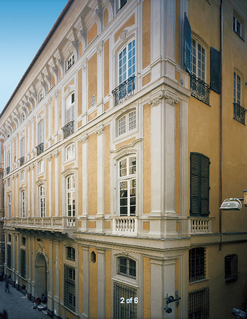
The Palazzo Doria or Palazzo Andrea e Gio. Batta Spinola is a palace located in Via Garibaldi, in the historical center of Genoa, in Northwestern Italy. It was one of the 163 Palazzi dei Rolli of Genoa, the selected private residences where the notable guests of the Republic of Genoa were hosted during State visits. On 13 luglio del 2006 it was included in the list of 42 palaces which now form the UNESCO World Heritage Site Genoa: Le Strade Nuove and the system of the Palazzi dei Rolli.
The following is a timeline of the history of the city of Trento in the Trentino-South Tyrol region of Italy.

The Mastodonte dei Giovi was a special double steam locomotive built specifically for use on the difficult Apennine stretch of the new Turin - Genoa railway line, inaugurated in 1853.
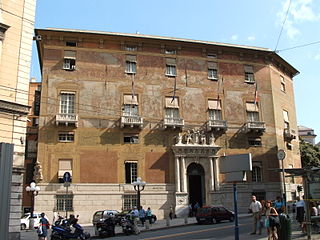
The Palazzo Doria-Spinola or Palazzo Antonio Doria is a palace located in largo Eros Lanfranco in the historical center of Genoa, Northwestern Italy. The palace was one of the 163 Palazzi dei Rolli of Genoa, one of those selected private residences where notable guests of the Republic of Genoa were hosted during State visits. On 13 luglio del 2006 it was added to the list of 42 palaces which now form the UNESCO World Heritage Site Genoa: Le Strade Nuove and the system of the Palazzi dei Rolli. The palace now hosts the Prefecture of Genoa and the seat of the Province of Genoa. It is possible to visit the areas of the building which are open to the public.
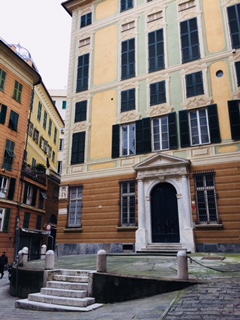
The Palazzo Clemente Della Rovere is a palace located in Piazza Rovere in the historical center of Genoa, Northwestern Italy. The palace was one of the 163 Palazzi dei Rolli of Genoa, the selected private residences where the notable guests of the Republic of Genoa were hosted during State visits. On 13 luglio 2006 it was added to the list of 42 palaces which now form the UNESCO World Heritage Site Genoa: Le Strade Nuove and the system of the Palazzi dei Rolli. The palace hosts today the General Consulate of Iceland.
Palazzo Doria may refer to a number of historical palaces and villas which belonged or still belong to the Doria family, originally De Auria, an old and extremely wealthy Genoese family who played a major role in the history of the Republic of Genoa and in Italy, from the 12th century to the 16th century.

Via Balbi is a street in the historical centre of Genoa, in Northwestern Italy, named after the aristocratic Genoese Balbi family. It is one of the Strade Nuove built by the Genoese aristocracy during the Renaissance. Since July 2006 it is inscribed in the list of UNESCO World Heritage Site Genoa: the Strade Nuove and the system of the Palazzi dei Rolli.

Via Cairoli is a street in the historical centre of Genoa, in North-western Italy, named after the 10th Prime Minister of Italy Benedetto Cairoli (1825-1889). Built in the 18th century as “Strada Nuovissima”, it is one of the Strade Nuove inscribed in July 2006 in the list of UNESCO World Heritage Site Genoa: the Strade Nuove and the system of the Palazzi dei Rolli.
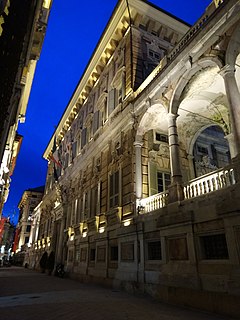
The palazzo Doria-Tursi or palazzo Niccolò Grimaldi is a building on Via Giuseppe Garibaldi in the historic town centre of Genoa. With Palazzo Rosso and Palazzo Bianco it houses the Strada Nuova Museums and on 13 July 2006 all three palaces and the streets around them became the Genoa: Le Strade Nuove and the system of the Palazzi dei Rolli World Heritage Site. Since 1848 Palazzo Doria-Tursi has also housed the city hall of Genoa.

















